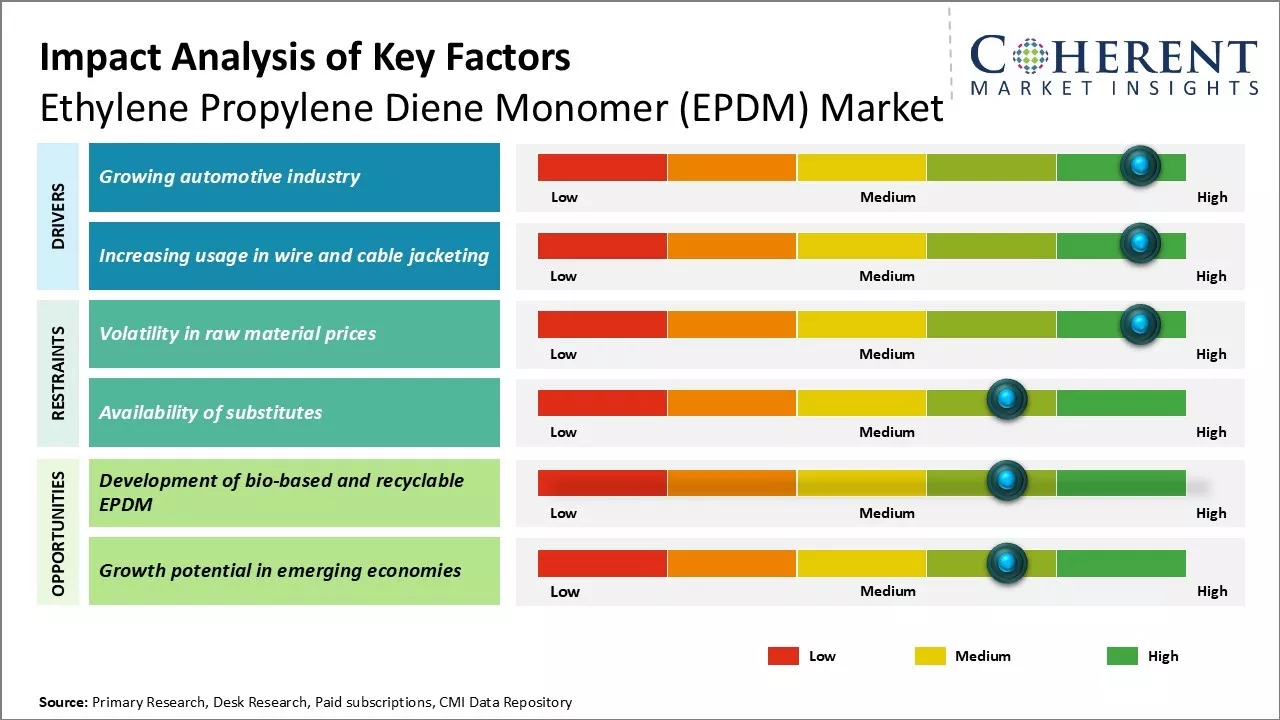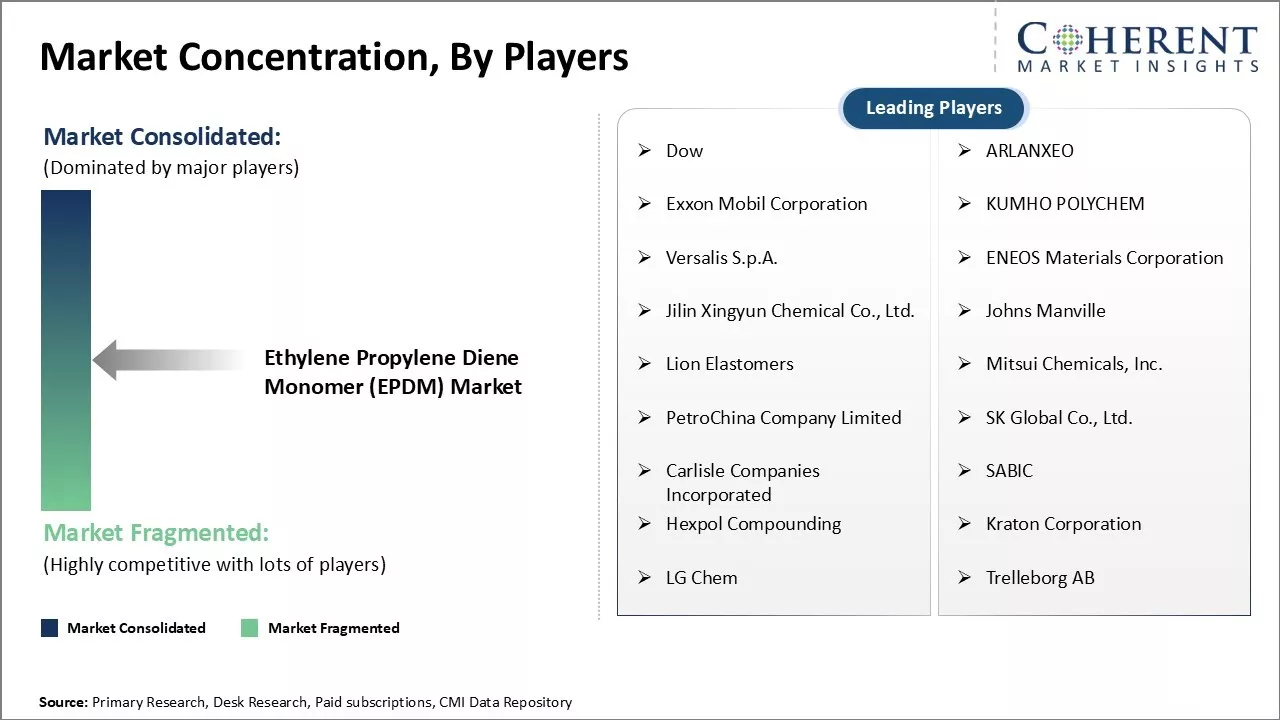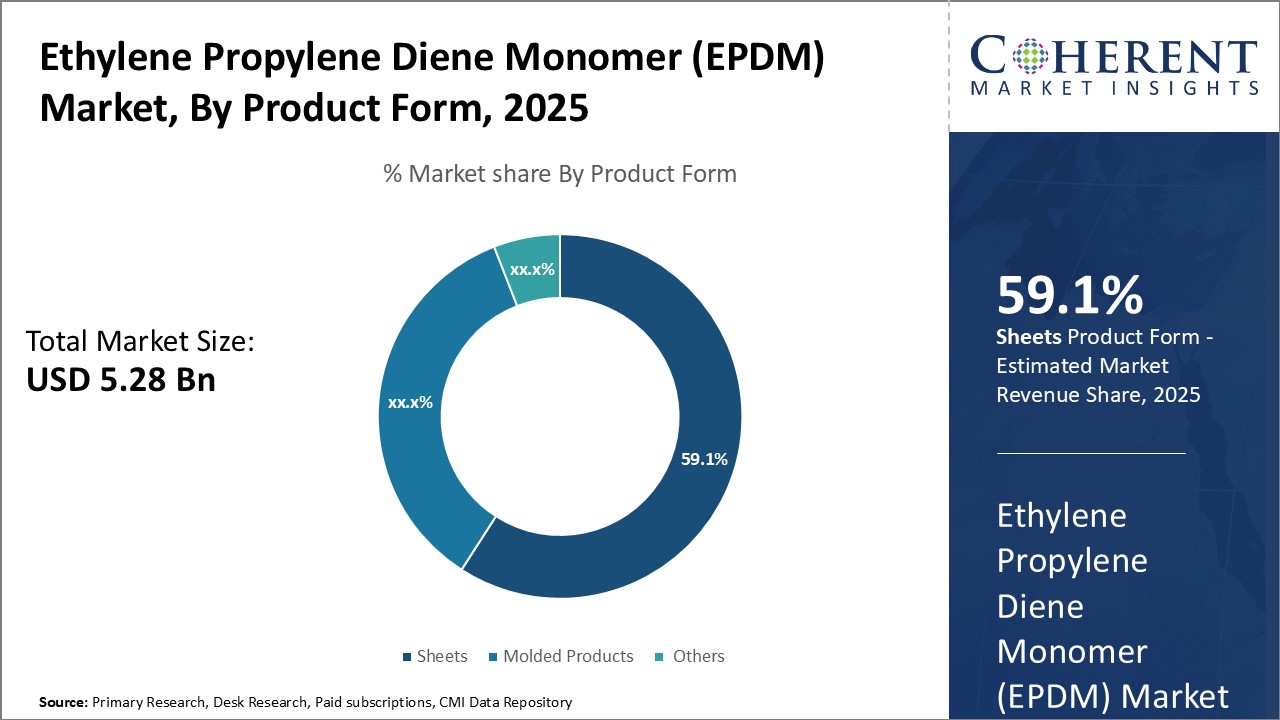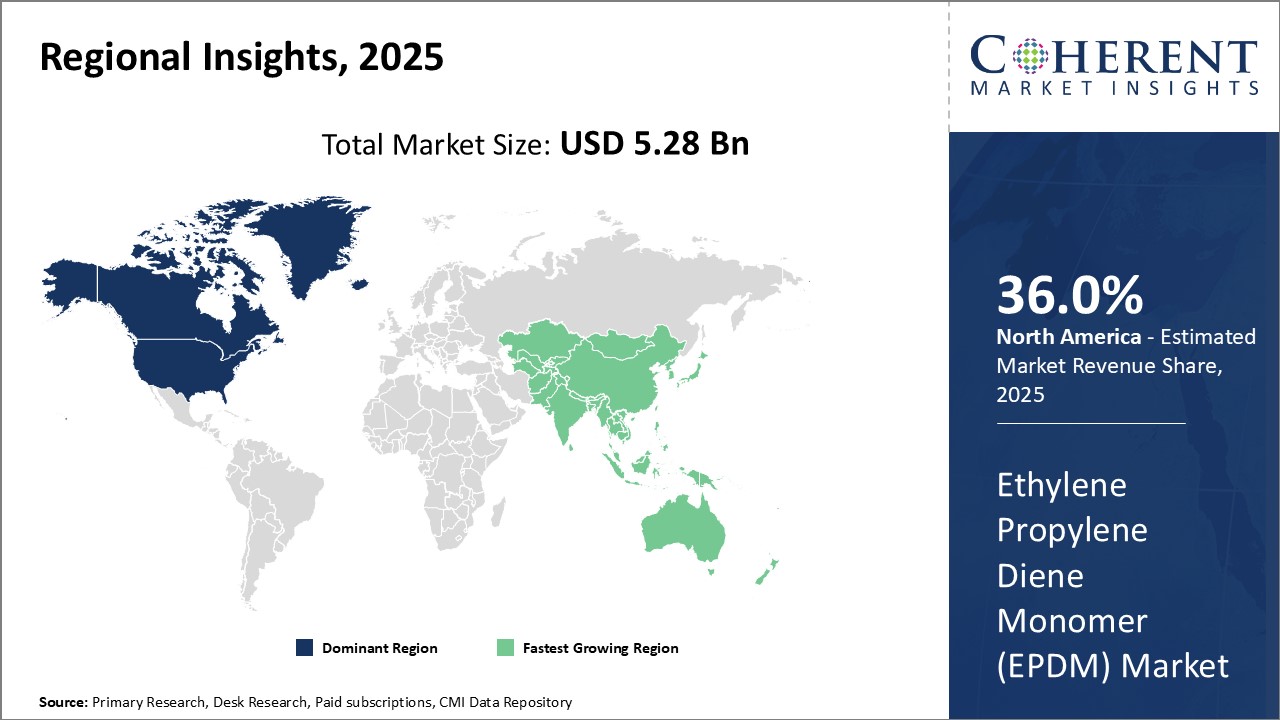Ethylene Propylene Diene Monomer (EPDM) Market Size and Trends
The Ethylene Propylene Diene Monomer (EPDM) market is estimated to be valued at USD 5.28 Bn in 2025 and is expected to reach USD 7.94 Bn by 2032, exhibiting a compound annual growth rate (CAGR) of 6.0% from 2025 to 2032.

Discover market dynamics shaping the industry: Download Free Sample
The market is driven by growth in the automotive industry where EPDM finds major application in manufacturing hoses, seals, and other components. Its good resistance to heat, chemicals, and aging has also increased its demand from various end-use industries like HVAC, wire and cable, and industrial rubber processing.
Market Driver - Growing automotive industry
The global automotive industry has been experiencing solid growth over the past few years which has significantly boosted the demand for EPDM. As EPDM is widely used in various automotive components and parts due to its excellent resistance properties, growing vehicle production directly translates to higher consumption of EPDM. Some of the key applications of EPDM in automobiles include window and door profiles, weather-stripping, hoses and belts, seals and gaskets. Global light vehicle sales have risen considerably over the last five years and many leading automakers are ramping up their production capacities across major markets to capitalize on strong demand trends. A lot of developing countries are also witnessing rising automobile ownership which is positively impacting the EPDM market.
EPDM is extensively utilized in weather-stripping applications as it helps in providing leak proof sealing and noise insulation. With increasing stringency of emission norms worldwide, automakers are focused on improving the insulation properties of vehicles which is propelling the demand for high-quality weather-stripping made from EPDM. Hoses and belts also make extensive usage of EPDM owing to its resilience against heat, oils and moisture. As automobiles are now more complex with growing number of mechanical parts, the demand for such specialized applications is observing a steady increase. Automakers are also incorporating more rubber components in vehicles to reduce weight and improve fuel efficiency in line with sustainability goals which creates meaningful opportunities for EPDM suppliers. The rising production of electric vehicles further complements the market growth as EV models generally employ more rubber components than conventional vehicles.
Market Concentration and Competitive Landscape

Get actionable strategies to beat competition: Download Free Sample
Increasing usage in wire and cable jacketing
EPDM has emerged as one of the most popular materials for wire and cable jacketing, exhibiting high penetration in this segment. A few benefiting properties of EPDM that have led to its widespread adoption in the wire and cable industry include effective insulation, wide temperature and chemical resistance range, durability and flexibility. It provides robust protection to wire assemblies against environmental hazards, moisture ingress, mechanical stresses, and electromagnetic interferences. With growing construction activities and continuous infrastructural development worldwide, the demand for power, control, and communication cables is experiencing notable gains. Since EPDM jacketed cables can withstand harsh outdoor conditions and offer longer lifespan, there is increasing preference for these types of cables in various construction applications such as power distribution, low voltage wiring, instrumentation cables, mining, and tunnel projects.
Moreover, the rising complexity of modern buildings has augmented the need for sophisticated wire and cable infrastructure with higher performance specifications. EPDM meets these evolving requirements well by delivering consistently reliable insulation over a wide temperature range from -50°C to +150°C. It is also becoming a material of choice for flexible hoses, irrigation pipes, and other outdoor hosing applications subjected to weathering due to its impermeability to moisture and numerous organic compounds. EPDM utilization is further bolstered by the increasing penetration of renewable energy such as solar PV installations which extensively use EPDM insulated cables and wires. Overall, the exceptional electrical, physical, and chemical resistance properties coupled with design flexibility of EPDM make it absolutely critical for advanced wire and cable solutions of the future.
Key Takeaways from Analyst:
The building and construction industry will be a key driver as EPDM finds wide usage in roofing, gaskets, and hoses due to its exceptional properties such as flexibility, and chemical resistance. Additionally, steady growth in the automotive industry, where EPDM is used in sealing, impact modification and damping, will support market expansion. North America is projected to be the dominating regional market owing to increasing construction and automotive manufacturing activities.
However, the availability of substitute products such as thermoplastic vulcanizates (TPV) poses a major restraint. TPV provides better properties in terms of flexibility at low temperatures and easier processing. Environmental regulations regarding the production of EPDM can also limit market potential over the long run. Opportunities lie in exploring new application areas and developing enhanced EPDM grades that can replace traditional materials. Automotive manufacturers increasingly adopting EPDM in under the hood applications like belts could present an opportunity for market players.
In light of the above factors, the EPDM market is expected to witness steady expansion driven by the Asia Pacific region. Material developers need to focus on differentiating EPDM through improved properties and new application capabilities to maximize growth prospects in the face of substitution threat from TPV and regulatory challenges.
Market Challenge - Volatility in raw material prices
The EPDM market has been facing significant challenges due to the volatility in raw material prices. As EPDM is synthesized from ethylene, propylene and diene monomers, fluctuations in the prices of these raw materials impact the overall production cost of EPDM. In the last few years, the prices of crude oil and natural gas, from which ethylene and propylene are derived, have witnessed substantial swings mainly due to uncertain geopolitical conditions and supply disruptions. Similarly, fluctuations in feedstock prices also affect the prices of diene monomers which are sourced from coal tar or petroleum sources. The unpredictable shifts in input costs create uncertainties for manufacturers to determine the final price of EPDM. This makes it difficult for companies to maintain long term contracts with consistent prices. The volatility in raw material prices thus poses major challenges for EPDM producers to achieve stable profit margins and manage overall business operations smoothly.
Market Opportunity - Development of bio-based and recyclable EPDM
The EPDM market sees significant growth opportunity in developing innovative bio-based and recyclable varieties. With growing awareness about environment protection and sustainability, there is a rising demand for green alternatives to conventional petroleum-derived polymers. EPDM manufacturers can leverage this demand by developing bio-based EPDM utilizing renewable resources like plant oils and natural rubber instead of conventional monomers. Additionally, focusing on recyclable EPDM helps address the problem of plastic waste and supports the circular economy approach. Production of recyclable varieties of EPDM which can be recovered and reused for new applications opens new markets and ensures long term business growth. Developing sustainable EPDM product lines would help gain new customers and grow market share in the long run. It is a strategic opportunity area which companies are investing in through extensive R&D activities.

Discover high revenue pocket segments and roadmap to it: Download Free Sample
Insights by product form: Versatility and extensive usage applications
In terms of product form, sheets are expected to contribute 59.1% share of the market in 2025. Sheets form accounts for the largest share of the global EPDM market due to its unique properties and wide applicability across various end-use industries. As a sheet’s product, EPDM exhibits outstanding flexibility and elongation characteristics, making it highly deformable and durable. It can be easily formed, bent and stretched as per application requirements without cracking or breaking. This superior elasticity and moldability features of EPDM sheets enable their usage in numerous applications that require tight sealing or gasketing functions.
A major factor augmenting the demand for EPDM sheets is their extensive usage in the automotive industry for weather-stripping, door and window seals, trim, and other exterior and under-the-hood components. EPDM sheets provide excellent ozone and weather resistance along with heat resistance of up to 150°C, proving ideal for automotive sealing and gasketing. Their resistance to moisture, chemicals, and compression set over time adds to their suitability for maintaining a tight seal around openings on vehicles. EPDM sheets are also gaining prominence in the construction industry for roofing, flashing, pond liners, etc. given their high tear strength and flexibility even at lower temperatures.
Additionally, sheets made of EPDM find extensive employment as gaskets, O-rings, and hoses in industrial machines and equipment since they can withstand oils, solvents, and other industrial fluids extremely well. EPDMs unparalleled resistance to temperature extremes, cutting, weathering and chemicals compared to other elastomers has solidified its status as the sheeting product of choice. Overall, factors like versatility, formability, elasticity, and excellent sealing properties have made EPDM sheets the dominant segment in the overall market.
Insights by application: The largest growing application segment driven by stringent emission norms and focus on fuel efficiency
The automotive & transportation segment is expected to hold 45% share of the global EPDM market in 2025, owing to its extensive usage in under-the-hood and exterior components. EPDM polymers are extensively utilized by automakers worldwide to manufacture weather-stripping, tubing, seals, and other components that require heat and oil resistance. They help improve a vehicles performance, efficiency, and emission profile.
Stringent emission norms imposed by regulatory bodies worldwide focusing on lowering vehicle emissions and improving fuel economy have significantly boosted the demand for EPDM in automotive applications. EPDM components provide superior sealing that helps reduce air, gas or fluid leakage from engines and exhaust manifolds, contributing to better fuel efficiency. Additionally, evolving consumer preferences toward smaller and lighter vehicles have augmented the need for advanced elastomers like EPDM that can withstand high temperatures without degrading mechanical properties.
Another key factor propelling the usage of EPDM in transportation industry is the materials unparalleled resistance to oils, fuels, heat, ozone cracking and weathering. These properties allow EPDM to withstand harsh under-the-hood operating conditions and serve longer without replacement. This has prompted several automakers to replace older rubber materials with EPDM for enhanced durability of components. Expanding electric vehicles market is also opening new growth avenues as EPDM is increasingly replacing other materials in electric vehicle components as well.
Regional Insights

Need a Different Region or Segment? Download Free Sample
North America has established itself as the dominant player in the global EPDM market over the years. The region is expected to account for 36.0% of the market share in 2025. This region accounts for the largest share of the worldwide EPDM consumption primarily due to strong demand from various end-use industries like automotive, construction, and industrial machinery manufacturing. The automotive sector, in particular, depends heavily on EPDM for a variety of applications such as hoses, belts, gaskets and seals. Being the largest automotive market globally, North American automakers utilize significant amounts of EPDM annually. In addition, the robust presence of EPDM production facilities of major players such as ExxonMobil and Lion Elastomers across the U.S. and Canada has made this region self-sufficient in terms of supply.
Among the fastest growing regional markets for EPDM is Asia Pacific. Rapid industrialization and infrastructure development activities are driving the consumption of EPDM extensively in the construction and capital goods sectors across developing nations like China and India. The growing manufacturing process of Asia Pacific countries is also propelling the demand from the automotive industry. The cost competitiveness of EPDM manufacturing in Asia Pacific has enabled suppliers to gain market share in the exports market. Countries like China and South Korea have emerged as major exporters, with China is dominating the global EPDM trade flows. This region is quickly emerging as an alternative sourcing hub for EPDM globally. The attractive incentives offered by governments to promote rubber processing industries further cement Asia Pacific's rise in the EPDM landscape.
Market Report Scope
Ethylene Propylene Diene Monomer (EPDM) Market Report Coverage
| Report Coverage | Details | ||
|---|---|---|---|
| Base Year: | 2024 | Market Size in 2025: | USD 5.28 Bn |
| Historical Data for: | 2020 To 2024 | Forecast Period: | 2025 To 2032 |
| Forecast Period 2025 to 2032 CAGR: | 6.0% | 2032 Value Projection: | USD 7.94 Bn |
| Geographies covered: |
|
||
| Segments covered: |
|
||
| Companies covered: |
Dow, ARLANXEO, Exxon Mobil Corporation, KUMHO POLYCHEM, Versalis S.p.A., ENEOS Materials Corporation, Jilin Xingyun Chemical Co., Ltd., Johns Manville, Lion Elastomers, Mitsui Chemicals, Inc., PetroChina Company Limited, SK Global Co., Ltd., Carlisle Companies Incorporated, SABIC, Hexpol Compounding, Kraton Corporation, LG Chem, and Trelleborg AB |
||
| Growth Drivers: |
|
||
| Restraints & Challenges: |
|
||
Uncover macros and micros vetted on 75+ parameters: Get instant access to report
Ethylene Propylene Diene Monomer (EPDM) Industry News
- In 2023, Trelleborg Sealing Solutions unveiled its innovative H2Pro range of sealing materials, designed to meet the demanding requirements of various industrial applications. This new product line includes a specially formulated EPDM rubber that is engineered to perform exceptionally well in high-pressure environments and across a broad temperature spectrum.
- In 2022, ChemSpec Canada Inc., a subsidiary of the Safic-Alcan Group, was selected by Lion Elastomers as its official distributor in Canada. This strategic partnership allows ChemSpec Canada Inc. to distribute a range of Lion Elastomers' products, including Royalene EPDM, Royaledge EPDM, Royaltherm EPDM, and Trilene Liquid EPDM, throughout the Canadian market.
- In 2022, Lion Elastomers announced that Arisan Kimya San ve Tic. A.S. (Arisan Kimya) has been appointed as its official distributor for a range of products in Turkey. This partnership will enable Arisan Kimya to distribute several high-performance elastomer products, including Royalene EPDM, RoyalEdge EPDM, RoyalTherm Silicone Modified EPDM, Trilene Liquid EPDM, and Trilene FreeFlow EPDM.
*Definition: The Ethylene Propylene Diene Monomer (EPDM) market consists of the manufacturing and sales of EPDM rubber. EPDM is a type of synthetic rubber that provides excellent resistance to chemicals, temperature extremes, and weathering. It is commonly used in automotive applications such as seals, hoses, grease boots and weather-stripping due to its flexibility and resistance to heat and oxidation. Other key end-use industries of EPDM include construction, wires & cables, and industrial machinery manufacturing.
Market Segmentation
- Product Form Insights (Revenue, USD Bn, 2020 - 2032)
-
- Sheets
- Molded Products
- Others
- Application Insights (Revenue, USD Bn, 2020 - 2032)
-
- Automotive & Transportation
- Building & Construction
- Industrial Machinery
- Wires & Cables
- Others
- Regional Insights (Revenue, USD Bn, 2020 - 2032)
- North America
- U.S.
- Canada
- Latin America
- Brazil
- Argentina
- Mexico
- Rest of Latin America
- Europe
- Germany
- U.K.
- Spain
- France
- Italy
- Russia
- Rest of Europe
- Asia Pacific
- China
- India
- Japan
- Australia
- South Korea
- ASEAN
- Rest of Asia Pacific
- Middle East
- GCC Countries
- Israel
- Rest of Middle East
- Africa
- South Africa
- North Africa
- Central Africa
- North America
- Key Players Insights
- Dow
- ARLANXEO
- Exxon Mobil Corporation
- KUMHO POLYCHEM
- Versalis S.p.A.
- ENEOS Materials Corporation
- Jilin Xingyun Chemical Co., Ltd.
- Johns Manville
- Lion Elastomers
- Mitsui Chemicals, Inc.
- PetroChina Company Limited
- SK Global Co., Ltd.
- Carlisle Companies Incorporated
- SABIC
- Hexpol Compounding
- Kraton Corporation
- LG Chem
- Trelleborg AB
Share
Share
About Author
Yash Doshi is a Senior Management Consultant. He has 12+ years of experience in conducting research and handling consulting projects across verticals in APAC, EMEA, and the Americas.
He brings strong acumen in helping chemical companies navigate complex challenges and identify growth opportunities. He has deep expertise across the chemicals value chain, including commodity, specialty and fine chemicals, plastics and polymers, and petrochemicals. Yash is a sought-after speaker at industry conferences and contributes to various publications on topics related commodity, specialty and fine chemicals, plastics and polymers, and petrochemicals.
Missing comfort of reading report in your local language? Find your preferred language :
Transform your Strategy with Exclusive Trending Reports :
Frequently Asked Questions
EXISTING CLIENTELE
Joining thousands of companies around the world committed to making the Excellent Business Solutions.
View All Our Clients
